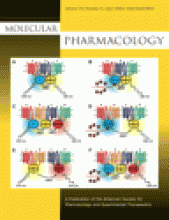Abstract
Homomeric 5-hydroxytryptamine (5-HT)3A and heteromeric 5-HT3AB receptors mediate rapid excitatory responses to serotonin in the central and peripheral nervous systems. The alkaloid morphine, in addition to being a μ-opioid receptor agonist, is a potent competitive inhibitor of 5-HT3 receptors. We examined whether methadone, an opioid often used to treat morphine dependence, also exhibited 5-HT3 receptor antagonist properties. Racemic (R/S)-methadone inhibited currents mediated by human homomeric 5-HT3A receptors (IC50 = 14.1 ± 2.5 μM). Incorporation of the 5-HT3B subunit into heteromeric 5-HT3AB receptors reduced the potency of inhibition by (R/S)-methadone (IC50 = 41.1 ± 0.9 μM). (R/S)-Methadone also increased apparent desensitization of both 5-HT3 receptor subtypes. The inhibition of the 5-HT3A receptor was competitive; however, incorporation of the 5-HT3B subunit caused the appearance of inhibition that was insurmountable by 5-HT. In the absence of rapid desensitization, when dopamine was used as an agonist of 5-HT3AB receptors, the inhibition by (R/S)-methadone was voltage-dependent. The antagonist and desensitization-enhancing effects of (R/S)-methadone were shared by pure (R)- and (S)-methadone enantiomers, which had similar actions on 5-HT-evoked currents mediated by 5-HT3 receptors. However, (R)-methadone exhibited a larger voltage-dependent inhibition of dopamine-evoked currents mediated by 5-HT3AB receptors than did (S)-methadone. Inhibition of 5-HT3A receptors by (R/S)-methadone was not influenced by voltage. Thus, methadone displays multimodal subunit-dependent antagonism of 5-HT3 receptors.
Footnotes
-
This work was supported by the National Institutes of Health National Institute on Drug Abuse [Grant DA05010] and the National Science Foundation [Grant 0447156].
-
ABBREVIATIONS: 5-HT, 5-hydroxytryptamine; HEK, human embryonic kidney; hERG, human ether-à-go-go-related gene; ANOVA, analysis of variance; NMDA, N-methyl-d-aspartate; Meth, methadone.
- Received November 5, 2008.
- Accepted January 8, 2009.
- The American Society for Pharmacology and Experimental Therapeutics
MolPharm articles become freely available 12 months after publication, and remain freely available for 5 years.Non-open access articles that fall outside this five year window are available only to institutional subscribers and current ASPET members, or through the article purchase feature at the bottom of the page.
|






